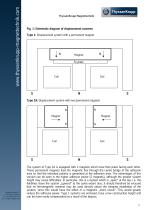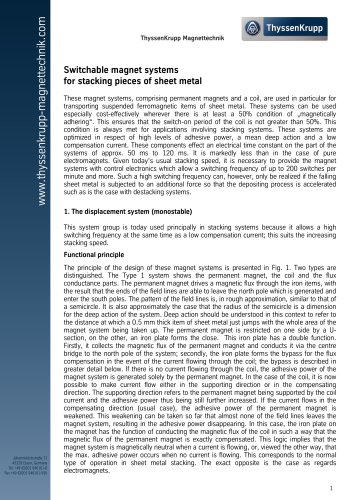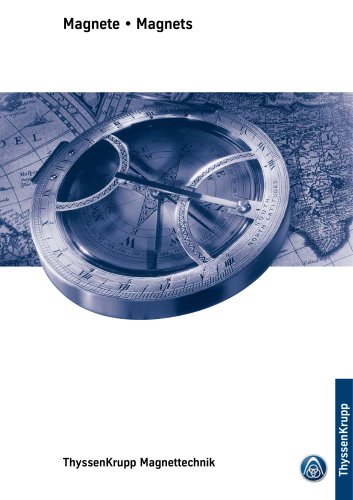 Website:
ThyssenKrupp Magnettechnik
Website:
ThyssenKrupp Magnettechnik
Group: Schulte
Catalog excerpts

ThyssenKrupp Magnettechnik Switchable magnet systems for stacking pieces of sheet metal These magnet systems, comprising permanent magnets and a coil, are used in particular for transporting suspended ferromagnetic items of sheet metal. These systems can be used especially cost-effectively wherever there is at least a 50% condition of „magnetically adhering“. This ensures that the switch-on period of the coil is not greater than 50%. This condition is always met for applications involving stacking systems. These systems are optimized in respect of high levels of adhesive power, a mean deep action and a low compensation current. These components effect an electrical time constant on the part of the systems of approx. 50 ms to 120 ms. It is markedly less than in the case of pure electromagnets. Given today’s usual stacking speed, it is necessary to provide the magnet systems with control electronics which allow a switching frequency of up to 200 switches per minute and more. Such a high switching frequency can, however, only be realized if the falling sheet metal is subjected to an additional force so that the depositing process is accelerated such as is the case with destacking systems. 1. The displacement system (monostable) This system group is today used principally in stacking systems because it allows a high switching frequency at the same time as a low compensation current; this suits the increasing stacking speed. Functional principle The principle of the design of these magnet systems is presented in Fig. 1. Two types are distinguished. The Type 1 system shows the permanent magnet, the coil and the flux conductance parts. The permanent magnet drives a magnetic flux through the iron items, with the result that the ends of the field lines are able to leave the north pole which is generated and enter the south poles. The pattern of the field lines is, in rough approximation, similar to that of a semicircle. It is also approximately the case that the radius of the semicircle is a dimension for the deep action of the system. Deep action should be understood in this context to refer to the distance at which a 0.5 mm thick item of sheet metal just jumps with the whole area of the magnet system being taken up. The permanent magnet is restricted on one side by a Usection, on the other, an iron plate forms the close. This iron plate has a double function. Firstly, it collects the magnetic flux of the permanent magnet and conducts it via the centre bridge to the north pole of the system; secondly, the iron plate forms the bypass for the flux compensation in the event of the current flowing through the coil; the bypass is described in greater detail below. If there is no current flowing through the coil, the adhesive power of the magnet system is generated solely by the permanent magnet. In the case of the coil, it is now possible to make current flow either in the supporting direction or in the compensating direction. The supporting direction refers to the permanent magnet being supported by the coil current and the adhesive power thus being still further increased. If the current flows in the compensating direction (usual case), the adhesive power of the permanent magnet is weakened. This weakening can be taken so far that almost none of the field lines leaves the magnet system, resulting in the adhesive power disappearing. In this case, the iron plate on the magnet has the function of conducting the magnetic flux of the coil in such a way that the magnetic flux of the permanent magnet is exactly compensated. This logic implies that the magnet system is magnetically neutral when a current is flowing, or, viewed the other way, that the max. adhesive power occurs when no current is flowing. This corresponds to the normal type of operation in sheet metal stacking. The exact opposite is the case as regards electromagnets. 1
Open the catalog to page 1
ThyssenKrupp Magnettechnik Fig. 1: Schematic diagram of displacement systems Type 1: Displacement system with a permanent magnet Magnet Fe-plate Type 2A: Displacement system with two permanent magnets N The system of Type 2A is equipped with 2 magnets which have their poles facing each other. These permanent magnets lead the magnetic flux through the centre bridge of the adhesion area so that the indicated polarity is generated at the adhesion area. The advantages of this version can be seen in the higher adhesive power (2 magnets), although the greater system height may cause difficulties....
Open the catalog to page 2
ThyssenKrupp Magnettechnik This configuration is recommended when RES magnets have to be used as a result of a high adhesive power requirement, because these magnets are markedly more difficult to compensate in the Type 2A configuration, since there is no bypass. As a result, the magnet itself must be weakened by the coil current. Owing to the high coil current, the heating is greater, leading to the possible switch-on period being shorter. The preferred use for displacement systems of Type 2A can thus be seen in the case of slower systems which have lower switching frequencies, such as in...
Open the catalog to page 3
ThyssenKrupp Magnettechnik 2. Bistable switchable magnet systems Viewed historically, this system type was the first electrically switchable permanent magnet system and is today of hardly any importance any longer because of its high pulse power when switching from the „magnetic“ state to the „neutral“ state. Nevertheless, it may be practical to use it wherever a low switching frequency is guaranteed and the „magnetically neutral“ state must be on over longer periods. The switching time of this type of magnet is usually markedly higher than that of the monostable systems. There are 2 types...
Open the catalog to page 4
ThyssenKrupp Magnettechnik the very different demagnetization curves of the two magnet types have been ideally combined. The high remanescence of the AlNiCo 500 cast is necessary so as to make available the necessary flux in as small a space as possible in the highly enclosed system; the coil diameter may thus be kept small, since the full hysteresis curve of the magnet traverses the coil field. In addition, it is also important that the AlNiCo magnet has a low coercivity so as to facilitate remagnetizing by means of the coil. On the other hand, the high coercivity of the ferrite magnet is...
Open the catalog to page 5All ThyssenKrupp Magnettechnik catalogs and technical brochures
-
Spreading Magnets
8 Pages
-
holding magnets
40 Pages
-
AlNiCo-Magnets
40 Pages











